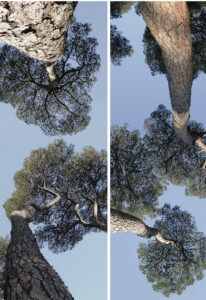The word “Cosmogony” has a Greek origin, steeped in ancient meanings, in which a complex etymological network that we can uniquely lead back to the doctrines on the origin of the universe is sedimented, with reference to all real and existing things. Thousands of years after the first use of this word, identified in the writings of the philosopher Leucippus from the fifth century B.C., which are for the most part lost, today speaking of cosmogony means dealing with a range of issues that travel from the observation of celestial bodies to the attempt to trace the evolutionary origin of the cosmos or, more specifically, the formation process of our planet. We are therefore talking about a finely layered concept over time, that contains multiple derivations and facets of a mythical, religious, astrophysical or esoteric speculation. In a certain sense, a discourse that also questions the origins of man as a terrestrial inhabitant and his relationship with the naturalistic datum.
The Cosmogony exhibition, hosted by the Carlo Bilotti Museum in Rome until 08 January 2023, leads to this imaginary. The curator Lorenzo Canova brought together the works of the artist Daniela Monaci and the poetic texts of the author Sonia Gentili, transformed into visual poetry installations by the artistic collective “L’uomo che non guarda”, which includes Gentili herself and Ambrogio Palmisano.
The theme of nature thus returns to make its way into the spaces of the Orangery in Villa Borghese, where the Museum is located, and it is in line with the past two editions of Back to Nature 2020-21, which brought contemporary art and its spectacular installations in one of the most important historical parks of the capital.
Cosmogony is here understood as the re-creation and prophecy of a new world, or rather of many infinite worlds for many infinite men, from which the lands of Monaci and the words of Gentili emerge. This dialectic allows the visitor to become a “creator”, as well as a “spectator”, and to put himself/herself in the shoes of the artist.
Monaci’s “cosmogonic” approach, made explicit by her artistic practice, consists in identifying, in a process of constant research, the dense plots that move the phenomenological evolution of creation and the elemental distortion of its essence. This investigation is conducted through the use of an extraordinary variety of means of expression, from photographic processing to computers with mixed techniques to installation works in clay or fabric, from video installations to the tableau vivant.
Among the works on display we find the Vertigine series, consisting of “photopainting” images on which the artist intervenes digitally by exploiting the potential of the technological medium. Smarrirsi, in turn, suggests a strong sense of disorientation in observing human figures immerse and dissolve in heaps of fog suspended between interceptible places, as in a symbolic shipwreck.
With Arcipelago one comes across a constellation of maps inhabited by ceramic sculptures that meditate a reflection in which sky, earth and sea dialogue in an intimate and profound communion. For Monaci, ceramic represents a return to the materiality of things, an expedient to awaken a dormant sensoriality of the body. She remembers this by stating that: “ceramic is earth, water, fire”, her sculptures are three-dimensional elements placed on nautical charts and perforated in such a way as to propose paths and routes which, in tune with the purity of the aquatic element, identify routes variables that it’s up to the observer’s ego to define, according to his/her subjectivity and experiential baggage. With her surreal geographies, the artist manages to create imaginative worlds that lose any concrete and binding reference to reality to generate superstructures with fantastic tones, suspended and unrelated to the traditional concepts of time and space.
The symbolic and timeless journey proposed by the exhibition, divided into three rooms on the ground floor of the museum, continues and enters into a close sensorial relationship with the texts by Sonia Gentili, writer and poet, professor at “Sapienza” University of Rome. Gentili’s visual poems are composed on electronic sheets of paper that combine the verses in a literary arrangement that is completed over time: groups of words, phrases, gradually materialize according to rhythmic times that mark new readings for the same text. A writing that becomes an image in motion, which happens from the light and which dies in the dark, in the silence of the creation of a desolate interior landscape. The pieces on display come almost entirely from her new collection I quattro gesti della creazione (Aragno 2020); four are taken from it while the other four are unpublished.
Arianna Cordeschi
Info:
Daniela Monaci and Sonia Gentili. Cosmogonia
Museo Carlo Bilotti Aranciera di Villa Borghese
Via Fiorello La Guardia, Roma
16/06/2022-08/01/2023 (prorogata)
www.museocarlobilotti.it
 Daniela Monaci, Vertigine n.1, Vertigine n.4, courtesy Museo Carlo Bilotti Aranciera di Villa Borghese
Daniela Monaci, Vertigine n.1, Vertigine n.4, courtesy Museo Carlo Bilotti Aranciera di Villa Borghese
 Daniela Monaci, dalla serie Smarrirsi, courtesy Museo Carlo Bilotti Aranciera di Villa Borghese
Daniela Monaci, dalla serie Smarrirsi, courtesy Museo Carlo Bilotti Aranciera di Villa Borghese
 Sonia Gentili / collettivo “L’uomo che non guarda”, Genesi e nella Terra, courtesy Museo Carlo Bilotti Aranciera di Villa Borghese
Sonia Gentili / collettivo “L’uomo che non guarda”, Genesi e nella Terra, courtesy Museo Carlo Bilotti Aranciera di Villa Borghese

is a contemporary art magazine since 1980






NO COMMENT